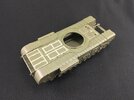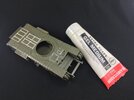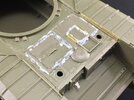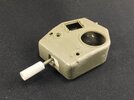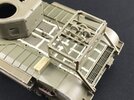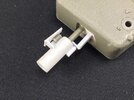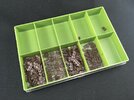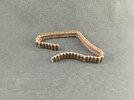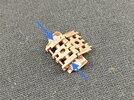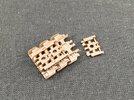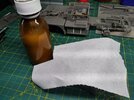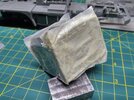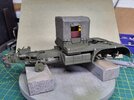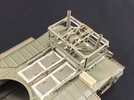- Joined
- Apr 28, 2018
- Messages
- 10,972
- Points
- 113
- First Name
- Jakko
Aside from the articles he wrote, I only know him through Missing-Lynx, but he seems a friendly enough person 
When I was working on those panels yesterday evening, as I set down the model on my workbench at one point, both wheels of No. 10 suspension arm on the left-hand side broke off — almost certainly because the model has all that weight in the back now and its front suspension raised, so without the bridge, all of it leans on stations 9 and 10. First thing I did this afternoon, as far as this model is concerned anyway, is make something to avoid that happening again:
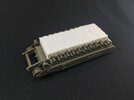
Just a piece of 2 cm thick styrofoam, about as long as the hull floor and wide enough that it wedges between the wheels. The model now sits flat on that instead of on its rear wheels.
That done, I continued work on the hull top:
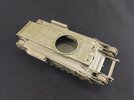
As an aside, in step 1 you have to drill holes through the sponson sides for the conical bolt heads and some of the AVRE fittings. The bolt heads need 1.5 mm holes, but the AVRE fittings (parts M11, L5 and L6 — I prefer L7 myself ) are a very tight fit then, so I drilled their holes out to 1.6 mm and they went on fine. Also, the easiest way to add the bolt heads is to just pick one up with a moist fingertip, push it into place, and run some liquid cement around it.
) are a very tight fit then, so I drilled their holes out to 1.6 mm and they went on fine. Also, the easiest way to add the bolt heads is to just pick one up with a moist fingertip, push it into place, and run some liquid cement around it.

When I was working on those panels yesterday evening, as I set down the model on my workbench at one point, both wheels of No. 10 suspension arm on the left-hand side broke off — almost certainly because the model has all that weight in the back now and its front suspension raised, so without the bridge, all of it leans on stations 9 and 10. First thing I did this afternoon, as far as this model is concerned anyway, is make something to avoid that happening again:

Just a piece of 2 cm thick styrofoam, about as long as the hull floor and wide enough that it wedges between the wheels. The model now sits flat on that instead of on its rear wheels.
That done, I continued work on the hull top:

As an aside, in step 1 you have to drill holes through the sponson sides for the conical bolt heads and some of the AVRE fittings. The bolt heads need 1.5 mm holes, but the AVRE fittings (parts M11, L5 and L6 — I prefer L7 myself

